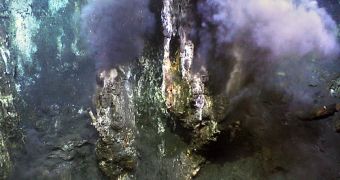A team of researchers from the University of Tokyo in Japan, found out that hydrothermal vents on the bottom of the ocean can generate electrical currents, and hypothesized that this could have led to creating the cradle of early life on Earth.
The team of researchers led by Ryuhei Nakamura says these electrical currents could have given birth to the complex carbon-based molecules that were necessary in order to create life.
These ocean vents bring minerals that contain iron, sulfur and copper, from inside the Earth's crust to the seabed.
As these minerals have extra electrons, Nakamura's team wanted to find out whether they could generate an electric current in the vent.
This goal led to the first lab-based electrical experiment on a type of sulfur-rich chimney called a black smoker, which was extracted from a hydrothermal vent in the middle of the South Pacific Ocean.
The researchers first passed a current through the chimney wall and saw that it could conduct electricity, and then they pumped hot, sulfur-rich water past one side of the chimney wall, and cold, salted water past the other, in order to recreate the conditions of a hydrothermal vent.
Their experiment resulted in a weak but stable electrical current, across the chimney wall.
Once Nakamura established that hot, sulfur-rich water flowing through a sea-floor vent triggers a weak electrical current, his team speculated that the chimney walls catalyze the conversion of sulphides into elemental sulfur while the hot vent fluid travels through them.
This reaction releases electrons that go through the wall into the salt water outside, where they transform dissolved oxygen into hydrogen peroxide.
Nakamura's team assumed that this electrical current could provide a source of energy for bacteria, New Scientist reports.
Because there was hardly any oxygen around in the primordial ocean to sustain the current, as Nick Lane, a biochemist who studies hydrothermal vents at University College London, points out, Nakamura suggests that the oxygen was replaced by carbon dioxide.
If his theory is correct, then the carbon dioxide was converted into carbon-based molecules, creating complex organic molecules on the early Earth's sea floors, a sort of 'primordial soup'.
In the lab, black smokers generate electricity, but the next step is to see whether the same thing happens on the bottom of the ocean.

 14 DAY TRIAL //
14 DAY TRIAL //